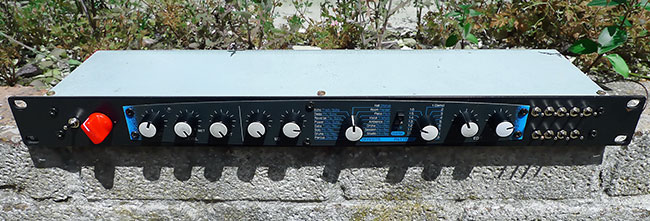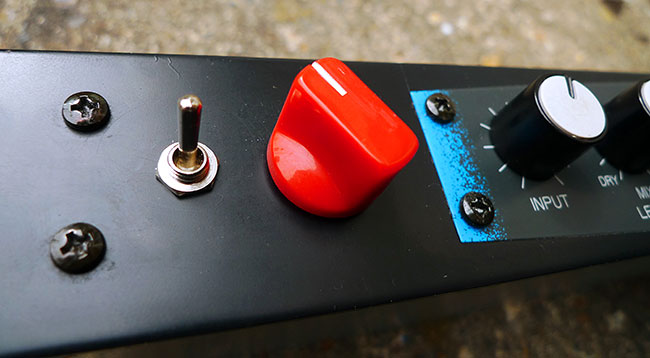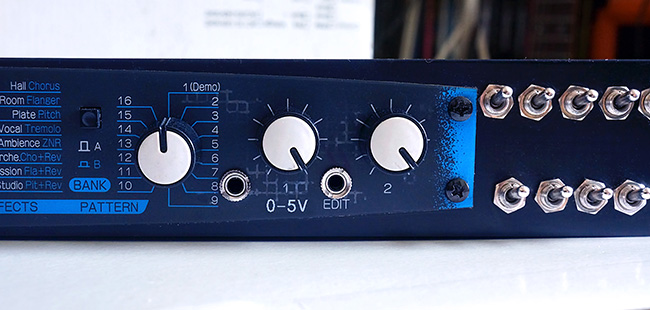ZOOM 1202 MODS: £95-£110
(Installed on your machine by circuitbenders)
The Zoom 1202 was released in 1995, two years before the 1201, but we're not going to question the wisdom of Zooms model numbering policy here! ;-)
There are two versions of the Zoom 1202. The one shown here is the version with a rear casing that runs the full length of the front panel. Modding this version costs £95.
The other version has a rear casing that only extends the width of the knobs on the front panel, as thats how wide the internal PCB is.
Presumably Zoom wanted to save some money and reduced the case size on later versions, although both versions have screw holes for mounting both size rear cases, so who knows. This smaller cased version will cost £110 to mod as it involves a bit more work to get the wiring to run cleanly out of the casing to the mod controls.
If you were looking at getting hold of a 1202 for modding purposes we would advise tracking down the larger case version, as they seem to be a little more reliable.

In many ways the 1202 can be considered the more sensible brother of the 1201. It doesn't have any of the bizarre stuff like the 1201's vocoder, Lo-Fi FX and ring modulator, but it does have a selection of more serious studio effects with some decent reverbs, delays, chorus and pitch shifting etc. Two benefits that are found on the1202 that are missing on the 1201, are low and high EQ knobs, and two edit knobs instead of just the one. These allow you to set delay times independently for the left and right channels, along with controlling the wider range of parallel effects that can be found on the 1202 i.e. a delay on the left channel and reverb on the right etc.
Essentially the 1202 will sit quietly in your rack just getting on with it, while the 1201 is busy pissing in the sink and vomiting on the curtains.

This more refined nature for the 1202 does come with a major benefit when the unit is circuit bent, in that with the addition of a reclocking knob the reverbs stay remarkably intact as you clock the unit down to slower system speeds. As the clock speed of the system slows, the reverbs become more and more granular until early reflections turn into creaking glacial lumps of noise and tails decay into a huge sea of sound. Unlike with many similar units, running the system at these low clock speeds doesn't introduce horrible squealing aliasing noise, or a floor of hissing white noise making the effect unusable. The reverbs produced may be unlike anything you've ever heard, but they are definitely a product of the audio fed into the unit rather than being completely disconnected sound.

The 9 way switching matrix operates on any effect that uses the onboard RAM. This includes the reverbs, delay, chorus, flanger, etc.
The switching matrix allows you to apply what sounds like various kinds of comb filters, pseudo ring modulation, bit crushing, distortion, and what can only be described as audio smearing™. Each switch has a certain effect variation that is usually associated with it, such as a certain frequency of sample chopping or distortion intensity, although its effect can be altered depending on which other switches are activated simultaneously. You have to activate more than one switch at a time for any new effect to be applied, but when two or more switches are activated their associated effects will combine to produce something new. Usually the original signal is not effected, but the effect signal will be, i.e. in a delay setting the original dry signal will pass through the unit unscathed, but the actual delay signal will be mangled beyond recognition..
Certain switch combinations on certain effects cause whatever is in the RAM at the time to be frozen and looped until the switches are released. This is especially effective on delay effects where echos can be grabbed and looped around while a sound is playing through the unit to create strange fills and breaks. This is shown to good effect on the percussion sounds and breakbeat in the 2nd demo below
Theres also the most exciting of all our mods............. a power switch!
The demos below show a selection of the effects these mods can produce. The first is an example of reclocking the reverbs. The second demonstrates the delay and loop freezing effects, while the third is some random bent acid effects.
EFFECT PARAMETER CV INPUTS: £50

This extra mod add two control voltage inputs to the front panel that can use an external 0-5v CV input from a modular synth, midi to cv converter or other voltage source to adjust the settings of the EDIT 1&2 parameter adjustment knobs in real time. Arguably its possibly not that exciting to adjust the reverb density or early reflections, but you can get some interesting results with things like delay, flanger or reverb decay parameters under control from an external CV sequencer.
Please note that the polarity and voltage protection of the CV inputs are set up to protect the 1202's CPU as a priority over what is supplying the CV. Probably 95% of kit that could be supplying a CV will have output protection so it would be perfectly fine to accidentally inject a negative, or slightly high voltage into the 1202, but there may be very badly designed kit out there where it could be problematic. Stick within the 0-5v range if you can. Plugging a jack into the CV input automatically disables the edit knobs.
This mod is only available if the main mods above are also being installed at the same time.
If you want your ZOOM 1202 modded get in touch using the CONTACT form.






